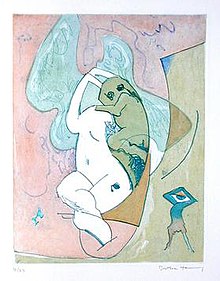Feminist
Dorothea Tanning (1910-2012),
Etched Murmurs,
etching, 1984. Having celebrated her 100th birthday in August 2010, Tanning was the oldest living original Surrealist painter.
Feminists
have in the past critiqued Surrealism, claiming that it is
fundamentally a male movement and a male fellowship. Feminist critics
believe that it adopts archaic attitudes toward women, such as
worshiping them symbolically through stereotypes and sexist norms. Women
are often made to represent higher values and transformed into objects
of desire and of mystery.
[79]
A pioneer in the feminist critique of Surrealism was Xavière Gauthier, whose book,
Surréalisme et sexualité (1971),
[80] inspired further scholarship on the marginalization of women in relation to "the
avant-garde."
This perspective was anticipated and critiqued as misunderstanding
Surrealism's point in being a social critique and a reflection on the
individual's presuppositions so that they may be critically questioned.
[81]
Wolfgang Paalen eventually was the only Surrealist to defend feminism,
although in a very archaic sense. However it was Leonora Carrington, who
called Paalen "the only feminist of the whole group".
[82]
Art historian Whitney Chadwick has countered the critique of
Surrealism: "Surrealism also battled the social institutions - church,
state, and family - that regulate the place of women within patriarchy.
In offering some women their first locus for artistic and social
resistance, it became the first modernist movement in which a group of
women could explore female subjectivity and give form (however
tentatively) to a feminine imaginary."
[83]
Freudian
Freud
initiated the psychoanalytic critique of Surrealism with his remark
that what interested him most about the Surrealists was not their
unconscious but their conscious. His meaning was that the manifestations
of and experiments with psychic automatism highlighted by Surrealists
as the liberation of the unconscious were highly structured by ego
activity, similar to the activities of the dream censorship in dreams,
and that therefore it was in principle a mistake to regard Surrealist
poems and other art works as direct manifestations of the unconscious,
when they were indeed highly shaped and processed by the ego. In this
view, the Surrealists may have been producing great works, but they were
products of the conscious, not the unconscious mind, and they deceived
themselves with regard to what they were doing with the unconscious. In
psychoanalysis proper, the unconscious does not just express itself
automatically but can only be uncovered through the analysis of
resistance and transference in the psychoanalytic process.
[citation needed]
See also

No comments:
Post a Comment